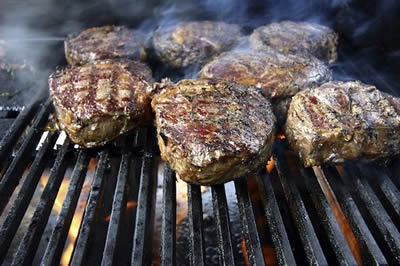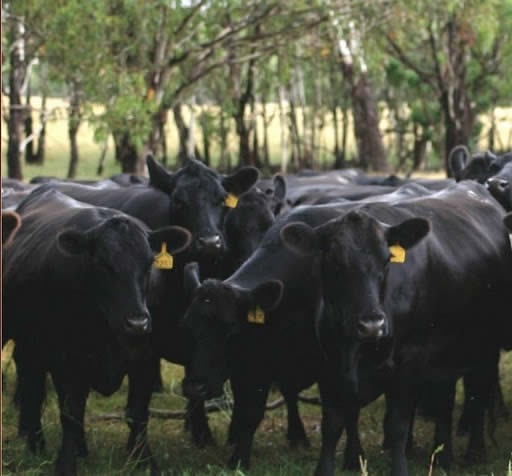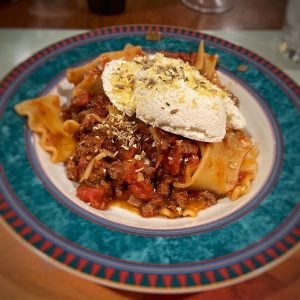Interview with Carrie Oliver about Artisan Beef
I immediately learned more about finding the perfect steak after reading an interesting article in The Wall Street Journal by Mark Schatzker called Having a Cow About Steak Quality. Hence, I researched and found The Artisan Beef Institute and Carrie Oliver. After exchanging emails and a phone call, I asked Carrie if she would answer a few questions about “Artisan Beef, what it is, why we should be buying it, and where to find it.”
As you will learn from this interview, Carrie is a wealth of information and is happy to share it with fellow steak lovers here and on her websites. She is currently working with several cattle producers. She has assembled a home-tasting kit at her Oliver Ranch Company for anyone who wants to compare four steaks from different ranches.
Enjoy the interview, and I welcome your comments at the end.
How did you get started in researching and writing about Artisan Meats?
This began as a personal journey. We wanted to buy beef that was genuinely naturally or organically raised but didn’t want to trade off flavor. Sadly, no one could tell us what was on our plates, and the steaks were random from week to week. When I discovered why, I was inspired and upset and decided to do something about it.
After careful study of the industry (and many beef tastings!), I realized that producing tasty beef is incredibly complicated. Flavor and texture can vary widely by farm, breed, diet, the age of the cattle, and many other variables. The industry has attempted to bring some order to this by seeking uniformity in cattle and promoting USDA Grade (Prime, Choice, Select) and marbling as the key quality indicators. Unfortunately, beef has become a commodity product focused on yield and throughput, not flavor.
I could break this commodity trap by going in the opposite direction and helping people discover and celebrate the wide range of flavors of different beef in North America. To do this, I created the concept of Artisan Beef. I founded The Oliver Ranch Company and The Artisan Beef Institute to find and support those producers who raise cattle with the same care and attention you see going into fine wines, gourmet coffees, chocolate, or even tomatoes.

Are you a big meat eater yourself?
I love to cook & eat meat, though, like many families, we eat less of it nowadays than we used to, especially pork and chicken. We also tend to eat smaller portions.
I know you are also involved with The Artisan Chicken Institute, with lamb and pork coming soon, but let’s talk now about beef and how to find the most flavorful, tender, mouthwatering steaks available. On your website, you say, “Beef flavor, texture, and quality are not driven by USDA grade or percentage marbling alone.” So then, what determines great flavor, texture, and quality?
I love this question, as the answer is so surprising: beef flavor, texture, and overall quality are influenced by the same factors as wine. The breed, quality of genetics (think rootstock), growing region, specific diet, husbandry practices, age at harvest, aging time and technique, and, importantly, the relative talents of the farmer, trucker, slaughterhouse workers, and butcher play an essential role. Marbling is just one factor. Moreover, some people find the marbled fat has a filmy or greasy feel and would rather avoid it.
The BIG difference between wine and beef is that with wine, one often wants to create stress in the grape. It is the opposite of beef; we never want stress – it can ruin flavor and texture.
When I go to the supermarket or Costco, where I buy a lot of my meat, I have no idea where that steak comes from or what breed it is. (you call this “Mystery Beef”) Why is it important to know where the beef comes from, what breed, and what it was fed?
If you think about it, how we currently buy meat is absurd. Would we buy ice cream with no idea what flavor it is? Would we choose our apples from a big barrel while wearing a blindfold? Why are we willing to buy mystery beef?
Fact: Some 800,000 beef cattle ranches in North America are raising hundreds, perhaps thousands, of different breeds and diet combinations. Highland, Hereford, Limousin, Angus, Charolais, or various crossbreeds—at your local supermarket, they can all be jumbled together and labeled “Choice” or whatever. Like the varieties of apples and the orchards that produce them, they taste different. Unfortunately, with supermarket beef, you have no information to help you pick the ones that you like best.
Have you ever had that experience where this week’s steak isn’t as good as the one you bought from the same store last week? I call this The Great Supermarket Lottery.
One of the best reasons to know the origins of your beef is that it can tell you how it will taste. Further, if you like that particular flavor and texture, you know where to buy more. You can also decide which farms and butchers you want to support – ones whose farming practices and animal husbandry you believe in.
I see more and more supermarket fish departments required to label where their fish comes from. Why are they not doing the same with our meat and will there be a day when they have to?
In 2009, the USDA started to require the country or countries of origin to be included on the labels of some fresh beef products (known as COOL). I suspect this was well-intentioned, but it doesn’t tell you much about the quality or flavor of the beef.
Plus, COOL is not required for smaller retailers, restaurants and cafeterias, butcher shops, or processed foods such as beef lasagna. I’ve seen ground beef packages that listed six countries on it (Products of the United States, Canada, Mexico, New Zealand, Australia, and Uruguay).
I would like to see retailers, butchers, and restaurants voluntarily offer far more information than this. At a minimum, as with wine, they should offer the name of the farm, feedlot (when relevant), breed, diet, and aging technique. Then, we will start getting some clues as to how the beef is going to taste.
Do the butchers at supermarkets even know the history of the beef they sell? Is the breed or ranch marked on the boxes it’s shipped in?
For the most part, I don’t think so, no. Most stores are selling what is known as “boxed beef” or”shelf-ready” beef. Some might specify a particular grade, brand name, grass-fed, or organic, but very few can name the farm, breed, region, diet, etc.
Processors seal major cuts (such as the whole Rib-Eye primal) with boxed beef in plastic bags and pack them into cardboard boxes. When the boxes arrive at the store, a meat cutter cuts them into individual steaks or roasts and packages them for sale. Many stores skip this step and order pre-packaged steaks, roasts, and ground beef from large processors.
Fortunately, some smart purveyors are responding to consumer requests for transparency. I encourage everyone to ask the name of the ranch, feedlot, breed, diet, aging technique, and whether the cattle were raised without growth hormones and preventative antibiotics. The more we ask these questions, the more people can answer them. I’ve created a guide with additional questions that I use to find Artisan Beef, too.

With your experiences of tasting steaks from around the country, can I even find a flavorful piece of meat in my local supermarket?
Sure, every once in a while, you’ll win The Great Supermarket Lottery.
But seriously, if you can’t find Artisan Beef or visit a farmers’ market in your area, you can do a few things to increase the odds of getting a flavorful steak.
- Start with steaks labeled as “naturally raised” or “organic.” The beef will at least have come from cattle raised without growth hormones, beta-agonists, or preventative antibiotics. These drugs are telltale signs that a producer aims to fatten cattle quickly and cheaply, not to produce fabulous-tasting food. They reflect a straight-up commodity mentality.
- Next, ask for dry or wet beef for at least ten days before being cut into individual steaks, as aging helps tenderize the beef.
- If your supermarket or local butchers carry it, try the grass-fed steaks (and burgers!). Some of the most delicious, flavorful beef is from cattle raised 100% on grass. (In part, this is because grass-fed cattle are typically a bit older – 18 to 24 months than commodity beef; beef from older cattle tends to have more flavor.)
It is essential to keep in mind that we all have different palates. If you like bold coffee, wines, and beer with complexity, you might prefer grass-fed beef and dry-aged beef, which are often more profoundly flavored and adventurous than wet-aged or grain-fed beef.
On a scale from 1 to 10, how would you rate a supermarket steak compared to one of the Artisan steaks you recommend at The Artisan Beef Institute?
Given the supermarket’s random selection, I don’t even compare them. Even if we “win the lottery” and happen upon a great steak at the grocer, it would be hard to repeat the experience since we wouldn’t know what we ate in the first place.
Speaking of ratings, you have developed a unique rating system and beef-tasting guide for home and professional cooks to use as guidelines for evaluating beef. Can you tell me a little about the system and how it works?

At the first steak tasting I hosted, I realized that we needed language to describe the beef we ate. This summarizes our vocabulary: beefy, meaty, gamy, juicy, and tender. Working with a team of wine and food sensory experts, ranchers, butchers, and chefs, I have developed an easy-to-use process and guide to help people describe and calibrate the aromas, flavors, and textures of meat and compare the differences between different farm & butcher teams.
The guide is purposely designed to be objective – there is no worst-to-best scale – and fun. You can use the guide to taste steaks or burgers from just one farm or compare different farms.
The key is to cook the beef the same way without fancy rubs or seasonings. For steaks, I recommend that people choose the same cut from each farm, ideally trimmed to the same thickness, season the steaks with unflavored kosher or sea salt, and cook the steaks to medium rare. Please avoid using pepper as it flavors the beef, and many people cannot taste past it.
As you taste each steak or burger, take notes and rate it. In the end, rank the steaks. After a few times doing this, most people will see a pattern emerge.
Please describe your three essential criteria – Texture, Personality, & Impression.
At the high-end quality, I find beef that is so good it will tell a story and evoke an emotional reaction in me or other tasters. Artisan Beef will distinguish itself on these three essential criteria – Texture, Personality, and Impression. Some people also like to explore specific flavor notes as well.
Texture is simple enough; it can range from very soft to very chewy. Some people like chewier beef than others. It would be best to consider whether the Texture of one steak or burger appeals to you more and why.
Next is Personality.
Let’s keep it fun (not intimidating like wine), so imagine if you could meet this beef at a dinner party; what kind of Personality would they have?
Is he reserved and shy? By the end of the night, you conclude that he’s just about the beef, i.e., there are no other flavor notes than just “beefy”? On the other hand, it is very adventurous, the life of the party. Do you taste many distinct flavor notes in the steak, such as blue cheese, caramel, toasted nuts, or even lamb?
This is important because some people find reserved Personality beefs elegant, while others find them boring. Adventurous Personality beefs are fascinating to some tasters but off-putting to others. It’s a matter of opinion.
Last, there is Impression.
Now that you’ve met this beef, will you remember him ten years from now, or did he leave just a fleeting memory? Did the flavors linger for a long time, or were they gone? Some prefer steaks and burgers with a brief impression, others a long-lasting one.
Once you get used to using my guide, I guarantee that a perfect steak will evoke an image in your mind. Was this an Outdoor Adventure Beef, Easy Going Beef, Seductive Date Beef, or something else?
You don’t have to like the steak for it to offer up an image, but Artisan Beef will be distinct. And the accompanying flavor notes will have you racing back to the source to buy your favorites repeatedly.
You say, “It is important to know that we are not seeking to find the “best” steak burger, chop, or roast. Thus, our scales do not go from worst to best.” Does this mean that everyone’s tastes are different, and I may like one steak style and you another? So, if I can define my tastes, I can seek out similar steaks with the same criteria.
Yes, when it comes to my tasting guide, that’s right. Once we get into Artisan quality, it is already great beef. We each have our taste buds and values regarding food, so it’s essential to have a guide to help you understand what it tastes like – don’t you agree?
I have been to many wine tastings and understand what to look for in a glass of wine, how a smell can describe so much about wine, and how it tastes while sitting in my mouth touching my taste buds offers enormous amounts of information about the quality of the wine and whether or not I will like it. Can I do the same with steak?
Yes and no. Steaks from different farms will have a unique aroma, and you can tell something about the texture by its appearance and feel to the touch (fine-grained is usually better, and generally, the texture should be soft).
You will likely develop an awareness of specific sensory attributes that please and do not please your palate. For instance, I am very sensitive to Ocean Notes in beef and pick those up just from the smell.
My experience tells me, however, that you need to eat the steak to truly identify its unique Texture, Personality, and Impression. With practice, you’ll learn how to make the right choice in beef just as with wine.
You speak a lot about the merits of grass-fed cattle on your website. Can you describe what a grass-fed cow is? Does that mean it eats no grain at all? Isn’t grain important to fatten up the cow?
All cattle eat grass. Yet most of them (over 95%) are “finished” on a diet that includes corn or other grains. “Grass-fed” means cattle that eat no grain at all. There are several different grass-fed standards. But ALL require producers to raise their cattle on pasture (vs. a feedlot) for a certain percentage of time and that cattle eat no grain. The American Grass-fed Association and Food Alliance standards are great – they also forbid the use of growth hormones and preventative antibiotics.
It is a myth that you must feed cattle corn or other grains to fatten them. Many grass-fed beef pioneers consistently produce well-marbled beef with a good fat cover.
I am a huge fan of grass-fed beef and burgers for a number of reasons. For one, I’m a flavor hound, and grass-fed steaks and burgers tend to be more intensely flavored and have more adventurous Personalities, which I prefer. From an environmental perspective, properly managing cattle raised on grass can help sequester carbon and enrich the soil. There are compelling arguments with regard to animal welfare and nutrition, too.
I’m an even bigger fan of Artisan Beef as it takes into consideration factors other than diet and husbandry practices alone, including flavor and community.
How prevalent are drugs in the cattle industry and what type of drugs are they using and why? Do they affect the overall taste of the meat?
As with humans, the cattle industry uses many drugs, including vaccines, to ensure livestock health. Controversy surrounds the use of a different set of drugs: growth promotants, including hormones and steroids, which are used to get cattle to grow bigger faster.
A new type of drug called beta-agonists is used to promote muscle mass, which again helps improve throughput and yield. Finally, some producers administer sub-therapeutic antibiotics to cattle to prevent them from getting sick and spreading disease to other cattle. (Some feedlots can house a quarter of a million head of cattle in a year.)
Few meat lovers know that growth hormones and beta-agonists can make beef tougher. Further, all these efforts to grow cattle faster work against those of us who enjoy having flavor in our beef. That’s because older cattle tend to be more intensely flavored. There are gustatory reasons to avoid commodity beef.
Does the breed of the cow really matter?
Yes, breed is a critical decision for any farmer or rancher. Some breeds and crossbreeds are better suited to some growing regions and climates than others. For instance, a longhaired breed that hails from the cold, wind-whipped, rugged Scottish Highlands may not thrive in the humid American South. (Remember, stress is bad for beef.)
In addition, breeds are genetically predisposed to certain characteristics including tenderness, marbling, heat and cold tolerance, mothering instincts, ease of birth, and countless other attributes that directly or indirectly impact flavor, texture, and quality.
Some will purposely select a breed that does not marble easily as they want to offer leaner beef to their customers. Others will choose a small breed because their customers like smaller portion sizes.
At the supermarket, I see a lot of promotions for Angus and Black Angus, which always cost more than the other non-Angus steaks. What’s so special about Angus and should I buy the hype?
Angus is technically a specific breed of cattle that originated near Aberdeen and Angus, England. There are Black Angus and Red Angus cattle. That sounds simple enough but in North America, Angus is often just a brand name. To be marketed as Angus beef, the USDA says the animal needs to be 51% or more black-hided.
Either that or the cattle must have at least 50% provable Angus genetics (one parent or both grandparents have the paperwork showing they are registered, Angus.) The USDA and some brands list a few other criteria, but Angus is often just a marketing term.
I should note that in most of my tastings, including my home tasting kit, I have included two or more Angus beefs, including several in which we compared two 100% Black Angus steaks from different farms. Ask any of the tasters, the steaks were strikingly different from each other.
I read on your web site that “Stress – which can be inborn, man-made, or from a natural event – can ruin the taste and texture of beef.” How in the world can I determine if a steak I want to buy comes from a cow that had a stressful life?
Because the color, texture, and pH balance are notably different, I understand that you will not find this beef on a supermarket shelf. A butcher can tell if there are any problems.
I have always understood that USDA Prime rated beef as the best, most expensive, and hardest to find. What is your understanding of these ratings and is Prime really that much better than Choice and if that’s the case, how inferior must Good (Select) be?
Despite conventional wisdom, marbling – the primary metric considered in the USDA grading system – plays a limited role in predicting the tenderness, flavor, and even juiciness of the beef. Many people do not realize that USDA grades are based solely on visual inspection. To me this is like determining the flavor and quality of a wine or apple based on how it looks. It’s a start but too simplistic. Lean beef can be very full flavored and tender.
At countless tastings, I have seen very lean beef do just as well as very marbled beef. Indeed, there are a number of people who do not like heavily marbled steaks or fatty burgers. Sometimes that fat can have a disagreeable mouth-feel, kind of a greasy or filmy aftertaste.
So What Do I Do? – Do you have some buying tips for home cooks searching for the real thing, that is a steak with incredible taste that won’t bankrupt the piggy bank?
Today, it is hard to find Artisan Beef as this is a new and unique approach to livestock rearing and meat production. I encourage people to use one of the questionnaires that can be downloaded from my site. It’s a tick list of questions that will get you most of the way. The rest is a matter of judgment and, of course, tasting the beef.
I also review, rate, and provide tasting notes on my site, host live Artisan Steak and Burger tastings, and offer a Discover Beef Experience Artisan Steak Tasting sampler for home tastings. I have found ranchers and butchers on my own, but many have contacted me directly.
People know that I’m interested in helping more producers, so many call, email, or send messages on Twitter or Facebook with the names of their favorites. Finally, as a consultant, I can help individuals, restaurants, and retailers find Artisan Beef or close to it.
The most powerful thing we can do is ask many questions about the origin of various meats. We must work together to encourage and even demand change in the meat industry.
Let me end with the fact that Artisan or Artisan Beef does not have to break the piggy bank! The three points I make in all of my tastings:
- Beef is like wine
- Low stress makes for better beef
- Buy by “the case”
When we taste a glass of wine or beer we really enjoy, we stock up. Why? Because we save money by buying in volume and get to have our favorite flavor on hand to enjoy whenever we like. The same works with beef. Buying a ¼ or a side of beef or joining a cow-pooling arrangement or CSA is a fantastic way to get a great price (typically less than commodity beef at retail) and eat the best beef style you like.








One Response
As a housewife, what can I do to eliminate or lessen the presence of growth hormone, beta agonist or antibiotics when preparing or cooking the chickens , pork or beef, bought from the market ? Please advise . Thank you .
Hi Bfkoon, great question and one you want to take up with a food scientist. I’m sure there are lots of great sites on the Internet with better information than I can offer. – RG